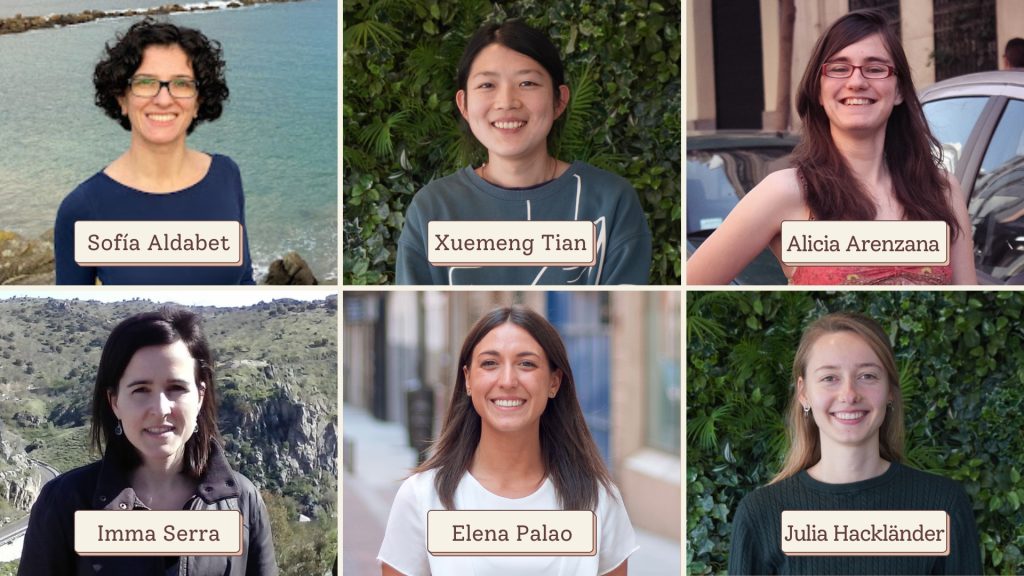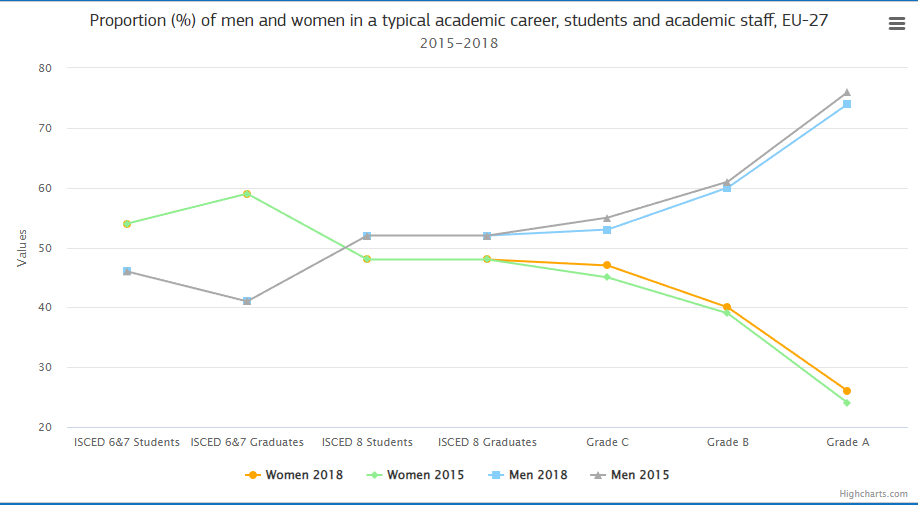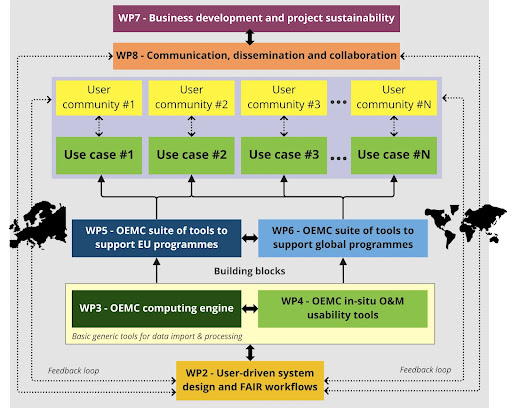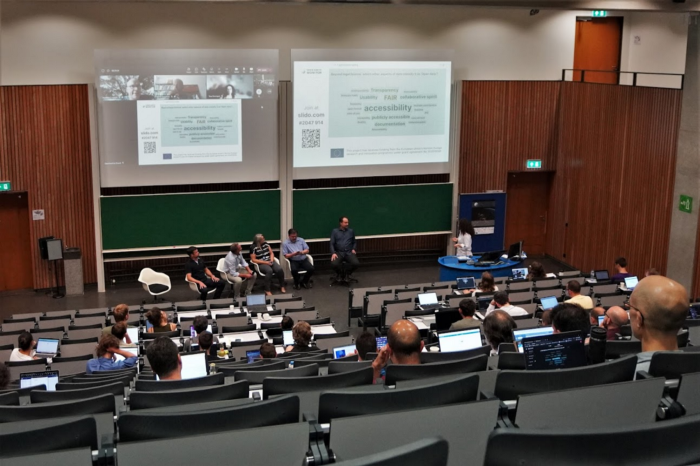An assessment of how far women have come and what’s left to overcome in honor of the 8th International Day of Women and Girls in Science
This article is a collaborative project between Valentina Delconte (OpenGeoHub), Alexander Wowra (Vizzuality) and Diego de la Vega (CREAF) and was originally published on Medium.com

“Science is not a boy’s game, it’s not a girl’s game. It’s everyone’s game. It’s about where we are and where we’re going.”
These famous words by former NASA Ambassador Nichelle Nichols encapsulate the truth. Research and innovations will advance the fastest the closer we come to closing the gender gap in the sciences.
Many tremendous achievements by women scientists have fallen short of the recognition they deserved throughout history. “Hidden female figures” who played transformative roles in the Science, Technology, Engineering and Math (STEM) disciplines like Marie Tharp, geologist and oceanographic cartographer who helped create the first scientific map of the Atlantic Ocean floor, Florence Nightingale, statistician and founder of modern nursing studies, Gertrude Cox, statistician and founder of the Department of Experimental Statistics at North Carolina State University, represent just a few of the many historical role models that should inspire future generations of girls to pursue their passions for numbers and models.
Today, there are actually some encouraging developments. Eurostat found that a majority of EU science workers are in fact women with a 26% increase from 10 years ago.
Yet, despite these gains, significant gender gaps still persist throughout Europe’s STEM disciplines with only about 26% of full STEM professorship positions held by women and only slightly less than every fourth head of institutions in the higher education sector being a woman as of 2019.
A UNICEF report argues that limiting women in the ways they can contribute to scientific innovations and technical advancements and hampering their rise in leadership positions ultimately hurts economic growth and perpetuates gender-based segregation and stigmas.
In other words, the more clearly society recognizes the rise of female scientists for the great opportunity it is, the more we all will benefit in the long term.
This is why, in the lead-up to the United Nations’ International Day of Women and Girls in Science, OpenGeoHub, Vizzuality and Centre de Recerca Ecològica i Aplicacions Forestals (CREAF) decided to invite women scientists to share their thoughts and their experiences working in STEM. In the following interviews, they share what science means to them and what they are actively doing to encourage new generations of girls to pursue their dreams.

Julia Hackländer and Xuemeng Tian
OpenGeoHub foundation, co-founded and co-led by Dr Ichsani Wheeler, is a Dutch geospatial research institute with a keen eye on the gender dimension of the data science sector. Here, Julia Hackländer and Xuemeng Tian have found a supportive environment where they are advancing their careers in data science and where they can merge their passions for the environment, programming and remote sensing.
Julia is currently starting her PhD focused on mapping land potential and tracking land degradation using earth observation data for the Open-Earth-Monitor project. From a young age, she was encouraged to explore the world of programming by her father, a programmer himself.
“I remember my parents gave my sister and me this book called HTML for Kids, and it certainly shaped our interests. And I think it is at that young age, where the support should start.” Julia said.
Xuemeng, on the other hand, described her choice to focus on STEM disciplines as a result of her ‘rebellious spirit’ and the appeal of the multifaceted career opportunities in science. Xuemeng decided to specialize in marine technology at the Ocean University of China in Qingdao, “a major where you learn how to study the ocean through marine remote sensing, marine acoustics, and marine optics.”
“What appealed to me the most in remote sensing is the fact that there are a lot of interesting problems that can be solved only with data, and I am really up for the challenge!” said the PhD researcher, who now works on spatial-temporal modeling of soil health indicators through a multiscale data fusion approach for the AI4SoilHealth project.
For both OpenGeoHub scientists, the gender discussion was on their minds during their studies. While Julia positively recalled that “ the difference in gender representation in data science is much smaller compared to some other STEM disciplines, such as engineering for example”, she also observed that the difference is more evident in higher job level ranks: “In my study, for example, almost all of my lecturers were male and most technical job interviews I had were led by men. I see this changing now along with new generations, but this transition still needs to be supported.“
“When I was studying for my Master’s, male students were actually outnumbered by girls, but I suspect that this was resulting from targeted policies and university regulations favoring women, which are still necessary in many cases to reach female participation in science, ” said Xuemeng.
She was actually fortunate to find a female role model in her MSc thesis supervisor, Professor Susan Steele-Dunne teaching in the Faculty of Civil Engineering and Geosciences at Delft University.
“She always brought courage and happiness to us. Thanks to her, I had the chance to experience so many things, and she was really good at listening to my opinions and requests. Besides being an excellent scientist and supervisor, she is a great mother. She balances different roles perfectly with her sincerity, wit and humour, which are the source of my inspiration.” said Xuemeng with a subtle smile on her face.
With an eye on the future, both scientists are hoping to see a more balanced gender representation with many new female leaders emerging in data science.
“To young girls choosing this career, I’d like to tell them to not let other people diminish them. Being alone with your personal experience may lead you to think that these barriers are part of normality. It is important to connect with other female scientists to exchange stories and support each other.” concluded Julia, underscoring the right of girls to choose the career that gives them joy without compromises.
Elena Palao, Sofía Aldabet and Alicia Arenzana
At Vizzuality, a science, tech and design company working on tools and projects related to the environment and sustainability, women scientists Elena Palao, Sofía Aldabet and Alicia Arenzana all struck a hopeful chord about gender issues in science.
“I consider myself very lucky because I have always been surrounded by great people that have respected me, both personally and professionally,” said Elena who worked in civil engineering and hydrology before joining Vizzuality.
Her fellow data science team colleague Alicia describes her career path in a similarly fortunate way: “Maybe I’ve been in a bubble but … I haven’t had a bad experience just because I was a woman in any of my jobs so far.”
The third member of Vizzuality’s women data science power-trio is Sofía. She has also been spared many of the struggles other women may face as they advance through a career in the sciences. “For some women it’s still difficult to believe that they can grow in a field full of men or that they can do something that until now mostly men did,” she said.
Looking back at her many professional and academic achievements, topped by the pursuit of a PhD in Geography, she pointed out that the sometimes rigid nature of academia can make it difficult for women to keep pace. “There are just moments in life in which it is not possible for many women to produce literature at the same rate as many men, which is not to say that men with kids don’t struggle too,” she said.
But while she has perceived that there may be more awareness in the private sector for the need for equality, she is convinced that overall gender gaps in both sectors are intertwined. “I think one is the reflection of the other…. So I think there is a general gender problem, especially in technical fields.”
Elena underscored these points adding that in the private and academic sectors, “stereotypes and unconscious bias can contribute to the lack of recognition for women’s contributions and in the gender pay gap.”
While Sofía, Alicia and Elena agreed that women can bring new valuable perspectives to the fields of science they were also keen to stress that this was not only a matter of gender but also diversity in general. “Diversity of origins and experience can bring a lot of value and different ways to look at science,” as Alicia put it.
Perhaps it is no surprise then, that inspiration from many different sources has been the driving force behind all their careers.
For Alicia, it was nature and her love for playing and working with hardware and electronics that originally set her on a path to environmental engineering.
Meanwhile, Elena drew inspiration from her grandfather who unfortunately died before she was born. She frequently encountered his legacy as a civil engineer on display all around her hometown. His work still stands and reliably serves people generations later, yet, maybe even more importantly, it touched the heart of his granddaughter who he would never meet. With her internal desire to become a civil engineer ignited, Elena began building her own career.
Sofía encountered many inspiring women throughout her life but right now she sees her colleagues in Vizzuality as role models. “Especially Alicia and Elena, because they are women, they are engineers, and they are senior scientists in a tech world that, with the exception of Vizzuality, is full of men.”
With their own career paths, experiences and sources of inspiration in mind, the trio of Vizzuality women scientists drove home one key message about what they view as the most effective ways to close the gender gap in STEM: Make science accessible and intriguing for young girls.
“First, girls need to be exposed to science. Without that awareness, it’s very difficult for girls to become interested and consider following this path,” Elena said. “ Secondly, science needs to be perceived as something attractive or portrayed in an interesting way, so girls can see the impact a career in science could have in the lives of others.”
Imma Serra
At the Centre de Recerca Ecològica i Aplicacions Forestals (CREAF) based in Cerdanyola del Vallès (Barcelona), Imma Serra works as a research technician in geospatial information systems and remote sensing, developing applications to process data in cloud environments.
Nowadays, Imma contributes to several GEOSS projects, such as the E-shape project – EuroGEOSS Showcases: Applications Powered by Europe and the Open-Earth-Monitor, but when she started her studies in Technical Surveying Engineering, female references weren’t available.
“When I finished secondary school, I wasn’t clear about what I wanted to study, but I realized that I liked math, in particular, trigonometry,” recalled Imma. “Also when I went on some trips I was always interested in looking at maps. This was when my curiosity started about these fields.”
Following her curiosity, Imma decided to study ‘something within engineering:’ “ When I started to study at the university, the degree in these areas fascinated me. I worked for two years as an engineer in surveying and then I decided to continue studying in order to broaden my studies and my career. When I studied topography there were more men than women. Later in the degree of Engineering in Geodesy and Cartography, the number of female and male students was more balanced.”
Today, to encourage more young girls in following a career path in STEM disciplines, the CREAF researcher also has taken part in STEM activities, speaking about her own career in primary schools.
“Most of them didn’t know anything about these areas of study beforehand. I think it is very important to make it known in today’s society, there are many stereotypes and some jobs associated with the roles of men and others with women. I believe that it is essential to show young girls different options in order to open their career horizons.” Imma concluded.
Final remarks
The testimonies shared by Julia, Xuemeng, Sofia, Elena, Alicia and Imma shed light on some of the stories of people behind the statistical numbers that indicate a promising yet still somewhat impeded rise of women in science. They are women with impressive, fascinating backgrounds, remarkable skills and a lot of knowledge to share. Research in STEM, as part of society, needs to keep up with all those women who contributed, who are contributing and who will continue to contribute to its development. The goal has to be to leave no one behind. Addressing this challenge should be a joint commitment as the reward will be valuable for everyone.
There is no silver bullet to achieving gender parity, but joining the conversation around #WomeninScience, undertaking actions for the visibility of women, creating the best working conditions for them and supporting female-led initiatives in STEM is definitely a good start.
Indeed, from what we teach at home, to how education and governments shape the conversation to opportunities companies promote, there is a wide range of possibilities to entice girls’ interest in science at a young age.
We want to thank all the interviewees for allowing us to have a valuable glimpse into women’s vast contributions to science. Their representation in STEM is a major opportunity for our society. By addressing the challenges hindering women in STEM, we open new doors for future students, workers and leaders benefitting the world economy and technological advancements.



